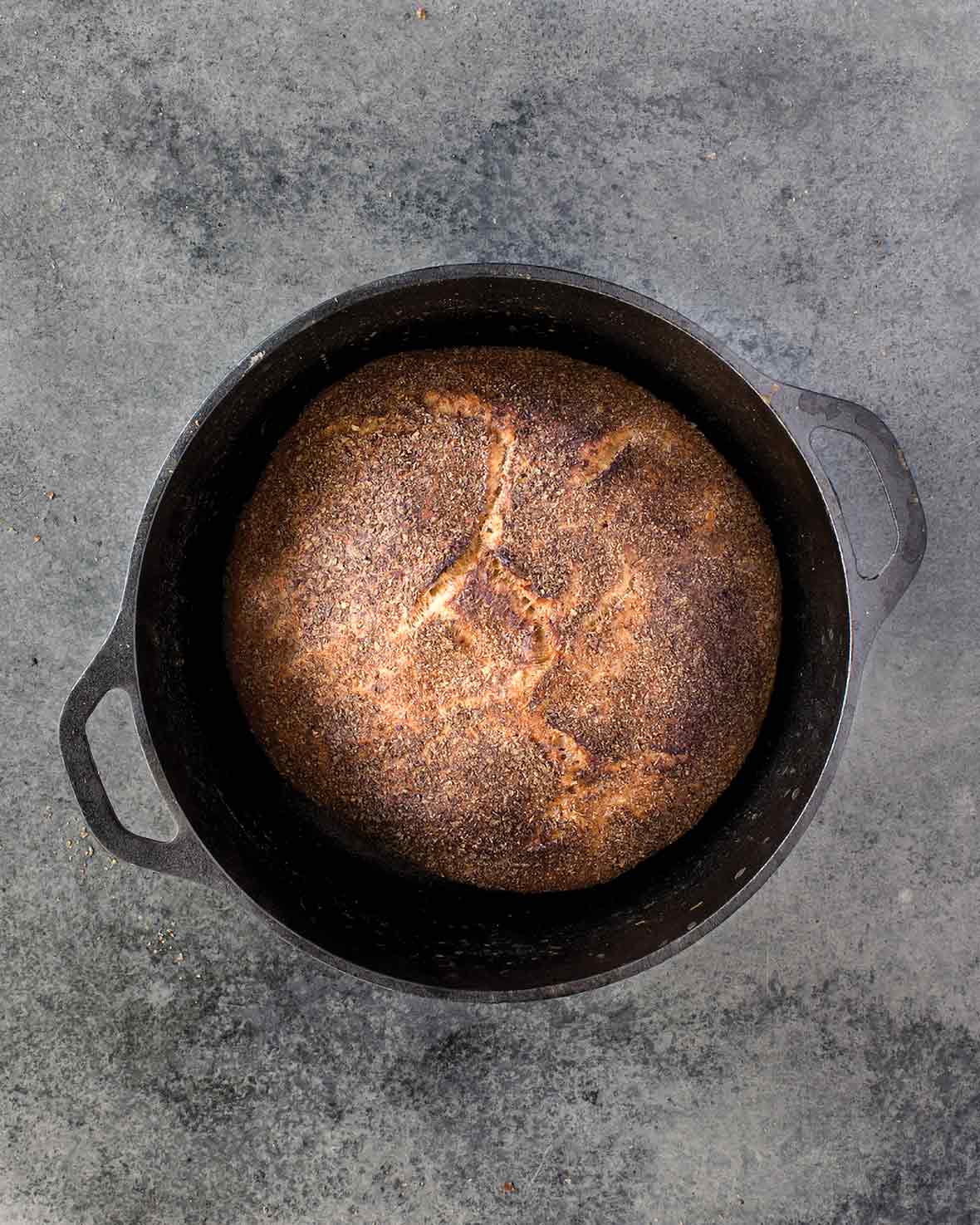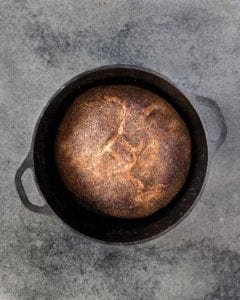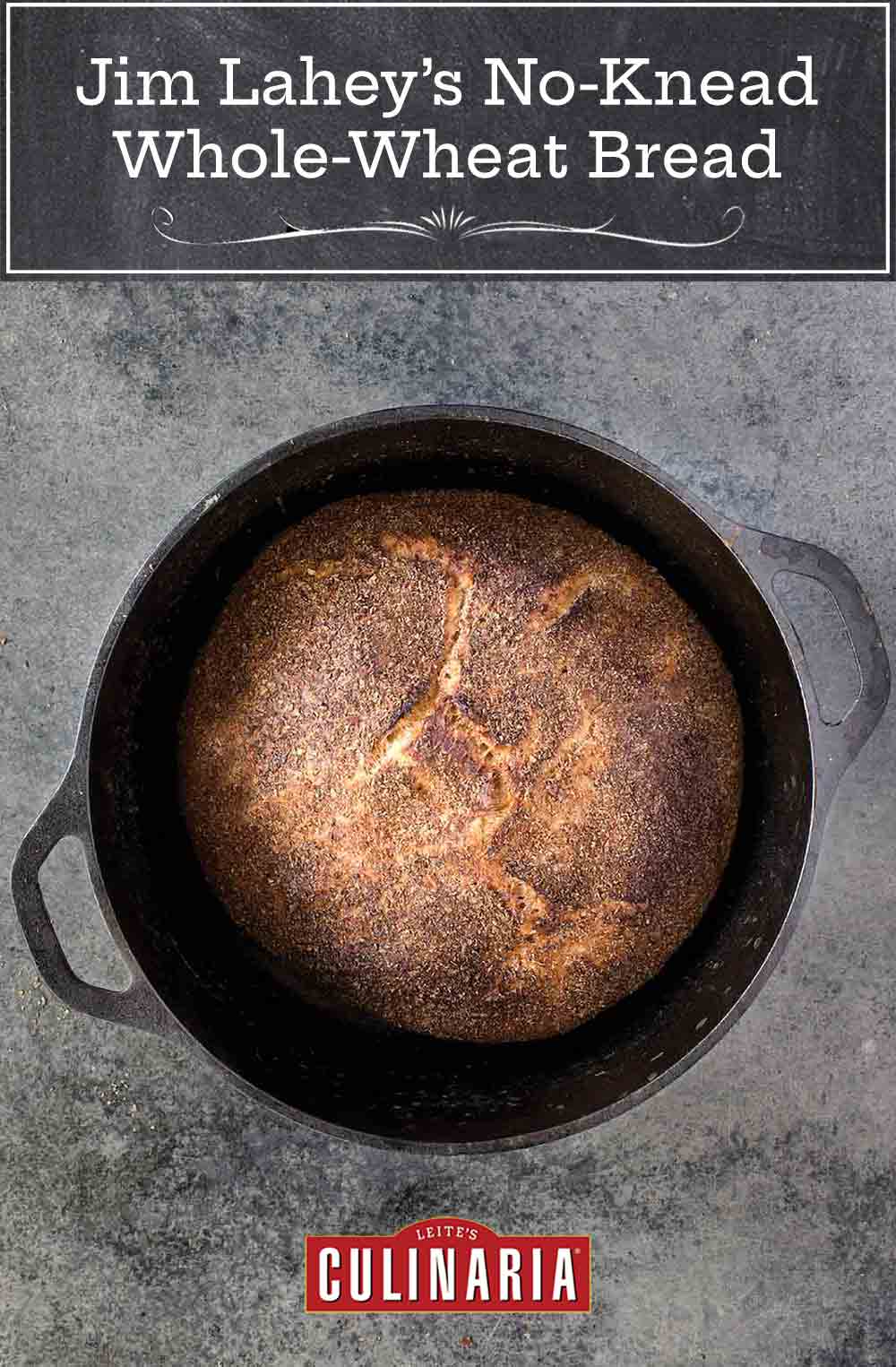
Jim Lahey’s no-knead whole-wheat bread is a brilliant innovation that brings you healthfulness with ease. And that’s to say nothing of the nutty, not overly healthful taste. More of that, please.–Renee Schettler Rossi

Jim Lahey’s No-Knead Whole-Wheat Bread
Ingredients
- 2 1/4 cups bread flour, plus more for the work surface
- 3/4 cup whole-wheat flour
- 1 1/4 teaspoons table salt
- 1/2 teaspoon instant or other active dry yeast
- 1 1/3 cups cool (55 to 65°F | 13° to 18°C) water
- Wheat bran, cornmeal, or additional flour, for dusting
Instructions
- In a medium bowl, stir together the flours, salt, and yeast. Add the water and, using a wooden spoon or your hand, mix until you have a wet, sticky dough, about 30 seconds.
- Cover the bowl and let it sit at room temperature until the surface is dotted with bubbles and the dough has more than doubled in size, 12 to 18 hours.
- Generously dust a work surface with flour. Use a bowl scraper or rubber spatula to scrape the dough onto the surface in 1 piece. Using lightly floured hands or a bowl scraper or spatula, lift the edges of the dough in toward the center. Nudge and tuck in the edges of the dough to make it round.
- Place a clean towel on your work surface and generously dust it with wheat bran, cornmeal, or flour. Gently place the dough on the towel, seam side down. If the dough feels tacky or sticky, dust the top lightly with wheat bran, cornmeal, or flour.
- Fold the ends of the tea towel loosely over the dough to cover it and place it in a warm, draft-free spot to rise for 1 to 2 hours. The dough is ready when it is almost double in size. When you gently poke the dough with your finger, it should hold the impression. If it springs back, let it rise for another 15 minutes.
- About half an hour before you think the second rise is complete, preheat the oven to 475°F (245°C). Adjust the oven rack to the lower third position and place a 4 1/2-to-5 1/2-quart heavy Dutch oven or pot with a lid in the center of the rack.
- Using pot holders, carefully remove the preheated pot from the oven and uncover it. Unfold the tea towel and quickly but gently invert the dough into the pot, seam side up. (Use caution—the pot will be very hot.) Cover the pot and bake for 30 minutes.
- Remove the lid and continue baking until the loaf is a deep chestnut color but not burnt, 15 to 30 minutes more. The bread is done when it registers 200°F to 210°F (93°C to 99°C) on an instant-read thermometer.
- Use a heatproof spatula or pot holders to carefully lift the bread out of the pot and place it on a rack to cool thoroughly.
- Slice and…sigh.
Notes
Jim Lahey’s No-Knead Whole-Wheat Bread Variation
Seeded Whole-Wheat Bread You can make this sturdy whole-grain loaf even more substantial–and satisfying–when you consider pretending you’re German and tossing in a handful of walnuts or maybe some pumpkin and sunflower sesame seeds when mixing the dough. Consider it bread that sprecheksn the Deutch. Slightly More (Or Less) Hearty Whole-Wheat Bread You can easily adapt this whole-wheat bread recipe to turn out loaves that are a little less hearty by tweaking the proportion of all-purpose to whole-wheat flours. The recipe currently offers a 3:1 ratio, but feel free to nudge it slightly up or down, making it closer to 4:1 or even 2:1 (all-purpose : whole-wheat) depending on how pale or dense a loaf you like.Nutrition
Nutrition information is automatically calculated, so should only be used as an approximation.
Recipe Testers’ Reviews
This no-knead whole-wheat bread is so simple to make it has become my go-to bread recipe. (I rarely buy bread.) It has a chewy crust and a well-developed flavor.
When making bread with all whole-wheat flour and/or if adding bran, I’ve found adding about a tablespoon of any kind of sugar or syrup really helps jump-start the yeast; otherwise it must sit for considerably longer than 12 hours to finish the first rise.
My favorite thing about this recipe is that it lends itself very well to experimentation, I’m still trying to figure out what combination and proportion I like best!
This no-knead whole-wheat recipe makes it easy to turn out crusty loaves of chewy whole-wheat bread that will have you turning up your nose at supermarket bread in no time.
It also invites experimentation, begging to be tweaked with more or less whole-wheat flour and the addition of nuts and seeds (flax? sunflower? pumpkin?). Loaves of bread don’t last long in our house, so there are very few days now when we don’t have a bowl of dough rising on the counter.











Hi, I would love to use only whole wheat flour to make this artisan bread. But I don’t understand what the meaning of “Go all the way with 100-percent whole-wheat flour, then drop down to 85 or 50 percent or lower.” Can anyone give me the recipe for using 100% whole wheat flour and the changes in any ingredients and steps if needed? Thanks.
Evon, you’re absolutely correct, that WAS really confusingly worded! Thank you so much for pointing that out. I’ve reworded that variation to be, I hope, much clearer. Can you kindly take a look and see if that answers your question? The author, Jim Lahey, had suggested that you can make it with 100% whole wheat flour although we haven’t tried that in our own kitchens so I think you’re going to have to go by feel and add a little more water if the dough seems to need it. The other steps remain the same although expect perhaps a slightly longer rise time and don’t expect to see the dough rise as much, of course, as bread made from white flour. Kindly let us know when you give it a try…
This is an excellent recipe and, especially, a new-to-me technique. I have been baking bread for years and years, and baking bread in a 100-year-old cast-iron Dutch oven has been a revelation to me. The recipe ingredients were absolutely correct for making a traditional 1 1/2-pound loaf of artisan bread. The no-knead revelation, coupled with overnight proofing, led to a perfect loaf. It’s an absolutely no-brainer. My normal method for making this artisan loaf takes three days! The only criticism of the recipe I have is that the author specified only “cool water,” implying that the baker use tap water. Chlorinated city water is not water you should use in making bread.
Superb, Ralph. Superb!
The result has provided much pleasure, but probably not as intended.
The dough was a difficult-to-handle sticky puddle during the whole process. There was raising during both cycles (However I did not see much bubbling on the dough surface), but in the end I ended up with a 5 cm (2 inch) high loaf with a 23 cm (8 inch) diameter (matching the shape of my Dutch oven). Great crust, chewy consistent, aerated texture (large and small bubbles).
I am a neophyte keen to learn the INs and OUTs of no-knead, so any feedback would be appreciated. Too much water? Insufficient flour? Substandard yeast leavening? (NOTE: I tested the yeast before use to ensure that it was active.)
Thanks!
Philippe, so sorry that you didn’t get the rise you were expecting. There are a few things that could be the issue, yeast being one of them. Even if my yeast seems active, I always make sure that it’s fresh, do I buy it often and keep it in the freezer. But I suspect the culprit here is the water-flour ratio. (Oh, did you use whole wheat?) I just added the metric amounts. Do you have a scale? Weighing is the most reliable way of making any baked good. Flour is just a pain in the ass when it comes to exact volume measurements. If you don’t have a scale, then I would suggest adding a bit more flour–up to 1/2 to 3/4 cup more–if you’re faced with that monstrous puddle again. That should help. Please keep me informed.